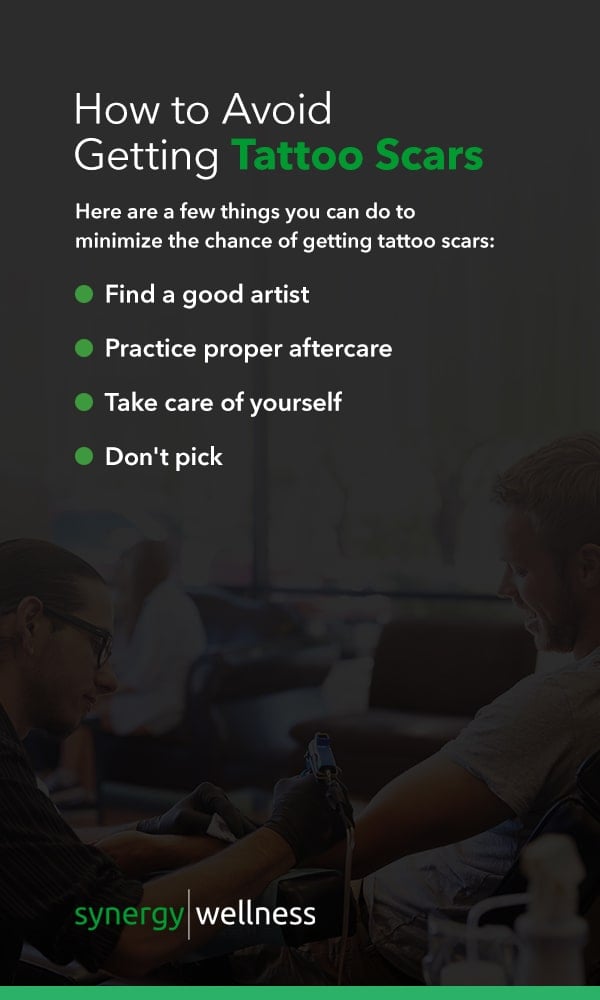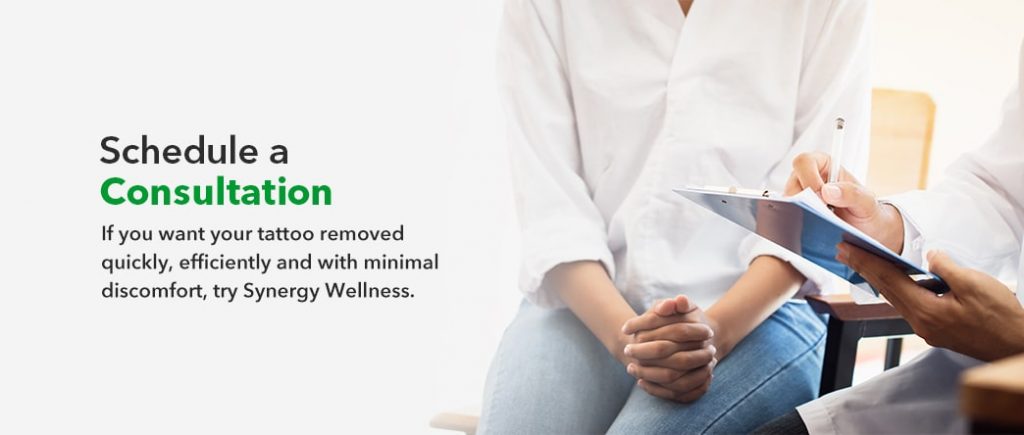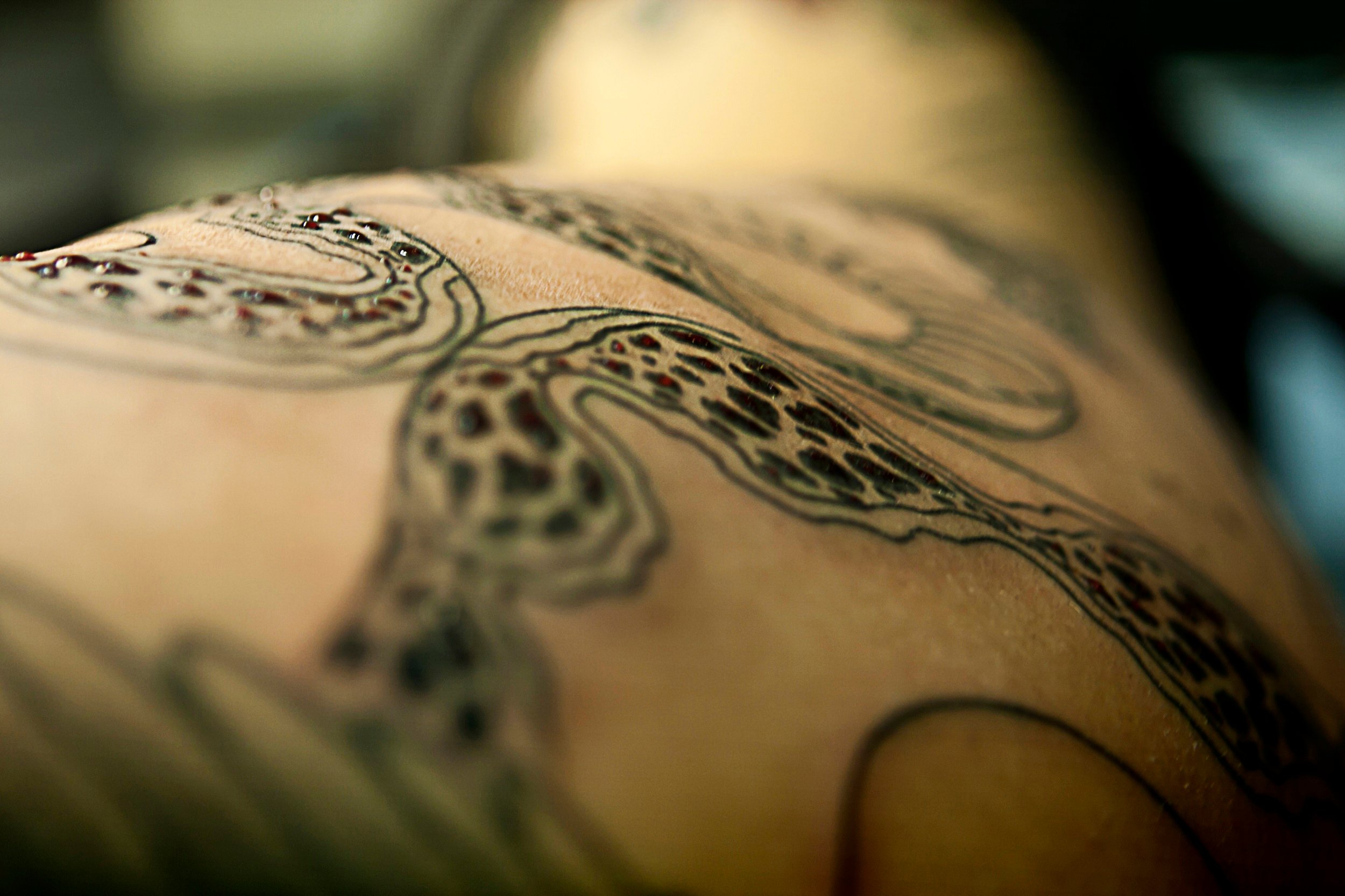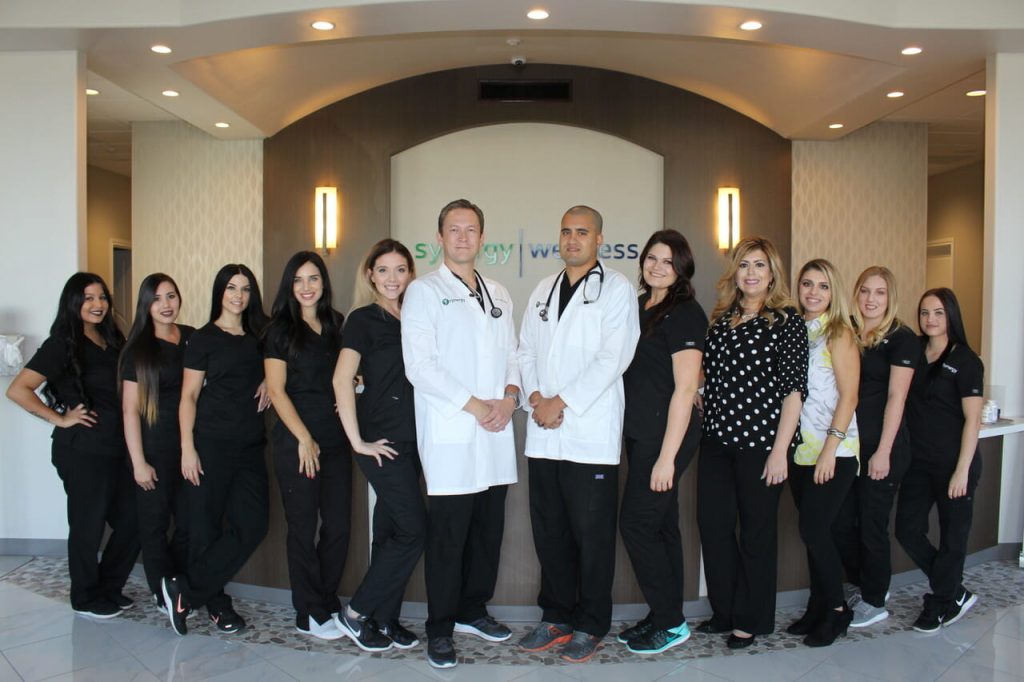For many years, tattoos have been a popular form of self-decoration. Artists can create beautiful, elaborate pictures directly on the skin, giving the recipient a piece of art that will follow them throughout their lives. However, tattoos can come with an unpleasant side effect — scarring.
Whether your tattoo is an elaborate back piece, a full-arm sleeve, or just a simple picture on your shoulder, there’s a chance that it’ll scar after healing. If you get the tattoo surgically removed, there’s a chance that will leave a scar as well. But why do tattoos scar? How badly will it affect the design? And most importantly, what can you do to prevent tattoo scarring?
How Do Tattoos Affect the Skin?
When you get a tattoo, the tattoo artist pierces the area with thousands of differently sized, ink-tipped needles. Depending on the size and complexity of the tattoo, this process can take between a few hours and several days of multi-hour sessions. They are, in essence, wounding your skin and leaving behind color to create a picture. And just like any wound, tattoos have to heal.
Everyone’s skin reacts to a tattoo differently, and everyone has different rates of healing. Initially, the skin will be red and inflamed due to irritation from the ink. Over time, the area will begin to scab over and peel. If the tattoo heals correctly, the wound will heal without visible scarring or raised skin. If it doesn’t heal correctly, however, the tattoo can become raised or distorted, which disrupts the image. If the wounds become infected, this also damages the picture, as well as extending the healing time.
How long the tattoo takes to heal varies from person to person. Things such as diet, the amount of sleep you get, and your overall health can influence how quickly you heal. The healing period can also be extended by infection, how deeply the tattoo artist penetrated the skin and whether or not you pick at the scabs that form. Ideally, a tattoo finishes healing between seven and ten days, leaving you with a smooth, clean image.
What Causes Tattoo Scarring?
Whether you develop a scar after receiving a tattoo will depend on many different factors both inside and outside your control, such as:
Heavy-Handed Tattoo Artist
While most tattoo artists know to dip the ink needle a millimeter into your skin, accidents can happen, and the artist may go too deep and cause a scar to form. Since these scars do not form due to an issue with the healing process, they may be difficult to see, and you may only realize you have a scar several weeks after your tattoo has fully healed.
Predisposition to Scarring
Depending on your genes, you may have a disposition to scarring. If you are genetically susceptible, you may already have scars from minor wounds like ingrown hairs.
Tattoo Peeling
Tattoo peeling is a normal part of the healing process, but if you do not practice aftercare correctly, this peeling skin can cause a scar. For example, if you pick at scabs and peeling skin, you can cause an infection, dislodge the tattoo ink or cause a scar. You can prevent peeling by applying lotion and avoiding tight-fitting clothes that can rub and chafe the skin.
Infection
Your body can develop an infection in several ways after receiving a tattoo. The main method is when dirt and bacteria get into the tattoo, or you develop an infection from poorly sanitized equipment at the tattoo parlor. For some people, their body has a negative reaction to the tattoo ink, resulting in an infection. If you notice red swelling, oozing or swollen lumps, it’s best to avoid picking or poking at your tattoo as it can result in a scar forming.

What Does Tattoo Scarring Look Like?
When a tattoo heals properly, the image should be clear and lie flush against the skin. There should be minimal discoloration, with the skin’s natural pigment affecting the ink. The skin also shouldn’t have pits or distortions. When the tattoo doesn’t heal properly, two types of scars can occur:
- Raised line scars: A raised line scar is a hypertrophic scar that looks like the typical raised scar you may see if you have experienced an injury.
- Growing bulbous scars: Growing bulbous scars, or keloid scars, can form from any skin wound. These scars can look like rubbery spots and spread wider than your tattoo.
Tattoo scarring occurs because the body heals wounds that run deeper than the superficial layer of skin. When the wound is superficial, the body can heal with minimal to no scarring. However, when the wound is deeper, the body cannot repair it with the same tissue. In these cases, it deploys scarring collagen, an elastic tissue that repairs wounds. This tissue, while helpful, is thicker than normal skin tissue and is therefore noticeable when stretched across larger wounds.
What’s the Difference Between a Tattoo Scar and the Skin’s Normal Healing Process?
If you hadn’t had a tattoo before — or even if you have — you might not be able to tell the difference between your skin’s natural healing process and healing that will lead to scars. However, there are a few symptoms that will let you know that your skin isn’t healing or hasn’t healed properly:
- Extended healing time: As mentioned, the ideal healing period for a healthy tattoo is seven to ten days. While the time it takes for a tattoo to heal can vary from person to person, an extended healing period can be a sign that it isn’t healing properly. If your scars still haven’t cleared up after two months, it’s likely that they’re there to stay.
- Discoloration: Redness and irritation is a natural part of getting a tattoo. However, if the skin is red, pink or otherwise discolored for a long period of time, the tattoo might not have healed properly. Certain kinds of discoloration, especially when paired with swelling or oozing, can also be a sign of infection.
- Raised skin: Ideally, a tattoo lies flat against your skin. If parts of your tattoo are noticeably raised, then there’s a buildup of scar tissue.
If you believe your tattoo is infected, it’s important to have it properly examined and treated before it has the chance to worsen.

How to Avoid Getting Tattoo Scars
It’s highly unlikely that anyone goes into a tattoo parlor wanting to leave with a scar. However, due to the fact that everyone’s skin reacts differently to the process, there’s no guaranteed way to avoid scarring, aside from not getting a tattoo at all. Thankfully, there are steps you can take to lessen the chances. Here are a few things you can do to minimize the chance of getting tattoo scars:
- Find a good artist: Many of the causes of tattoo scars begin at the tattoo parlor. If the tattoo needle is inserted too deeply into the skin, if the ink is too old, or if the needle hasn’t been properly cleaned, it can increase the chances of scarring during the healing process. A skilled tattoo artist will know how to minimize damage to the skin, as well as how to properly clean their equipment. Make sure to choose a reputable tattoo artist when getting a tattoo.
- Practice proper aftercare: Like any wound, a tattoo needs to be taken care of while it heals, both to prevent infection and to make sure it heals as quickly as possible. Keeping your tattoo clean is another way to minimize scarring. Make sure to keep the area covered and dry while it heals. You can cover it with a basic plastic film, or get a special healing film. You can also apply healing salves in order to soothe the skin and speed up the healing process. Ask about the best products to use at the tattoo shop.
- Take care of yourself: Keeping yourself healthy is another way to speed up your healing process. Avoid things like smoking, drugs and alcohol, which cause you to heal more slowly. Don’t expose your healing skin to too much directly sunlight, as this can cause sunburn. You should also avoid activities that can strain the skin of the affected area, such as heavy lifting.
- Don’t pick: As with any injury, scabs are there to help your body heal safely. The scabs that form over healing tattoos are no different. Picking at scabs or scratching at the healing skin will extend your healing process after getting a tattoo. It also leaves you more open to infections, as you’re continuously opening your wound.
It should be noted that even if you follow all of these steps, you can still end up with tattoo scars. If you suffer from certain medical conditions or have a history of healing poorly from cuts and scrapes, your tattoo is more likely to scar. If you fit these criteria, you get a tattoo at your own risk.
What About Scars from Tattoo Removal?
While temporary tattoos can be removed with soap and water, real tattoos are a different story. They’re meant to be a permanent addition to the body. However, there are times where people regret their tattoos and wish to have them removed. To do this, they usually turn to laser tattoo removal. This procedure involves breaking down the tattoo pigment using a laser.
However, a tattoo’s permanent nature means that even advanced removal techniques aren’t perfect. In many cases, residual pigment is left under the skin. What’s more, the process can also leave blisters and scars. However, there are several ways to reduce the chances of scars forming:
- Choose a reputable clinic: Similarly to getting a tattoo, choosing a reputable location is an essential part of laser tattoo removal. Some laser tattoo removal services use outdated technology that can lead to scarring. It’s important to make sure that the institute you choose uses advanced laser technology.
- Prepare in advance: Preparing your skin before the procedure will help it heal faster. Avoid using harsh chemicals, hot or high-pressure water or fragrant cosmetics on the area you plan to treat. Clean your skin gently, avoid strenuous exercise two to three days before the procedure, and stay properly hydrated.
- Don’t scratch: As with any healing skin, scratching or picking will only make it worse. It’s natural for skin to be sore, itchy or inflamed after the laser tattoo removal procedure. Even so, resist the urge to scratch or pick at it, as doing so will lengthen the amount of time it takes to heal and increase the chance of getting lasting scars.
- Take care of yourself: Staying healthy will encourage healing after the procedure. Stay hydrated, eat a balanced diet and get a healthy amount of sleep. Avoid exposing the affected area to direct sunlight, smoking or drinking after the procedure as well.
Aside from choosing reputable clinics, there’s unfortunately no way to reduce the chances of pigment being left under the skin. There’s also no way to guarantee that you don’t get scars from the procedure, although you should be able to avoid them with proper aftercare and a reputable clinic. The only way to guarantee you don’t get a scar from laser tattoo removal is the same way you avoid getting a scar from a tattoo — never getting it in the first place.

How to Get Rid of Tattoo Scarring
As with any scarring, tattoo scarring and tattoo removal scarring are permanent. Once the skin has been damaged deeply enough, the body cannot repair it with the same tissue and must instead use scarring collagen. However, scar appearance can be lessened over time or hidden superficially. Here are a few ways to do so:
- Aloe vera: Aloe vera is a plant with skin-soothing properties. Applying the gel to your skin can lessen the appearance of scars. You can also apply it to the skin as it heals to lessen the chance of scars forming then.
- Scar ointment: There are special ointments specifically formulated to lessen the appearance of scars. Using some according to the instructions can make scars less noticeable.
- Moisturizing: It’s important to keep your skin moisturized even before you get a tattoo, as dry skin is more prone to cracking and bleeding. If you moisturize your skin regularly, it will keep the skin hydrated and make your scars less noticeable.
- Makeup: If you can’t lessen the appearance of your scars anymore or simply wish to cover them altogether, you can apply makeup to your skin to hide them. The downside is that makeup only hides the color of scars and can also cover your tattoo. It also needs to be constantly reapplied, especially if you come into contact with moisture.
- Microdermabrasion: If your tattoo is completely healed, you can schedule microdermabrasion treatments. This process involves a chemical peel that removes the top layer of skin, helping the affected area look smoother and more even-toned.
If you’re truly desperate to cover up a tattoo scar, you can attempt to have it tattooed over. However, this isn’t recommended. First of all, depending on the size, shape and type of scarring, it might not be possible to cover it completely. Secondly, if you scarred from the first tattoo, there’s a chance you’ll scar from the second, which will just make the problem worse. Finally, tattooing over tattooed skin is more difficult than fresh skin, so the entire process will be more complicated than the first tattoo.
Skin Treatments for Tattoo Scarring
In addition to the above methods, there are also various skin treatments to lessen the appearance of tattoos:
- Dermabrasion: Dermabrasion uses a machine to abrade the top layer of the skin, removing it and clearing away small surface scars.
- Collagen injections: While collagen injections are usually used to treat wrinkles, they can also be used on pitted scars. During the procedure, collagen is injected under the skin, replacing the body’s natural collagen and plumping the skin.
- Chemical peels: During chemical peels, the top layer of skin is removed via the application of a chemical. While chemical peels are usually used for sun-damaged skin and irregular pigmentation, they can also be used to remove surface-level scars.
- Laser treatments: Laser treatments aren’t just for removing unwanted tattoos. It can also lessen the appearance of scars by using high-energy light to burn off damaged skin.
The effectiveness of each treatment varies depending on the type of tattoo scarring. Make sure to consider your options and pick the one that works best for you and your skin.
Why Trust Us for Laser Tattoo Removal?
At Synergy Wellness, our highly trained and extremely motivated team uses a holistic approach to help patients achieve their aesthetic goals. We are proud to have a team that includes experienced nurses, physician assistants, licensed aestheticians and, of course, our Synergy Visionary, Dr. Trobisch. Our years of experience and combined skills have helped many patients feel and look their best.
Besides providing expert advice on tattoo scarring, we offer our patients personalized treatment plans to assist them with their unique concerns. To learn more about our practice and the difference we’ve made for our patients, we invite you to consider our testimonials for authentic, first-hand accounts from our patients about the difference we’ve made in their lives.
Schedule a Consultation
Getting a tattoo can be a wonderful, long-lasting form of self-expression. However, due to their long-lasting nature, they can be almost impossible to remove once you have them. Advanced laser technology allows you to have your tattoo removed with minimal scarring, but it’s crucial that you choose a reputable location when scheduling your surgery.
If you want your tattoo removed quickly, efficiently and with minimal discomfort, try Synergy Wellness. Synergy Wellness in Bakersfield & Fresno, CA specializes in weight loss, anti-aging and medical aesthetic treatments, including laser tattoo removal surgery. Our specialists will remove your tattoo with minimal discomfort and maximum results, meaning you’ll be able to leave feeling more comfortable with your skin. Schedule a consultation today and bring your skin back to the way you want it.





